#the long dark lore
Explore tagged Tumblr posts
Text
The Long Dark Lore - The History of the Forest Talkers - The Long Dark
youtube
0 notes
Note
Might I inquire as to what, precisely, a Mustain't is? (Aside from a string of letters I hesitate to Google in that order.)
In October 2014 I went on a road-trip to the Driest Place In America.
I was having a rough year, very depressed from having dropped out of college for the third time. I decided a road trip was in order to re-set my brain and get a little distance. Being that it was October, and therefore all the campgrounds in the American Southwest were filled with people who have the good sense to camp in reasonable temperatures, I elected to take my parent's minivan so I could car-camp anywhere suitably isolated, and looked up some of the southwest's geographic extremes- the highest place I could drive to (Pikes Peak), the lowest place (Badwater Basin), and for fun, the Dryest Place in the continental US, which turned out to be the Pinacate Volcanic field just west of Organ Pipe Cactus National Monument. It gets rain maybe twice a century and has no standing water, despite being less than 100 miles from the gulf of California.
It's a startlingly beautiful and alien place. The ground is a deep chocolate brown to black volcanic sand, and in mid October, the rabbit brush is turning bright yellow as it shifts to autumn, the organ pipe cacti are a dark green and stand, partially concealed in the brush at exactly human height. The air is alive with birds and insects and bats at night. The stargazing is like looking into the eyes of God.
You get there by driving down a little dirt road called "El Camino Del Diablo", or "The Devil's Road".
I drove out about three hours from Glendale, AZ to get there, arriving at sunset, and felt a profound sense of peace. I stargazed, listening to the bats hunt and sing, and slept peacefully for the first time in months.
I stayed out there for three days, sketching and painting the landscape, taking strolls through this almost alien landscape, and enjoying the light and sound and total absence of human intrusion besides myself.
On the fourth night, it was a new moon, and I awoke in the middle of the night. Something was amiss, and it took me a while to realize it was because I could NOT hear the bats. I was sleeping inside the van with the rear windows rolled halfway down rather than trying to set up the tent, so I when I sat up, I looked out of the van's reflective windows to discover what at first appeared to be A Horse.
It was something between pale gray and bright white in the starlight, standing maybe a dozen feet from the van, sniffing curiously. It made sense- I was in the middle of mustang country and there was quite a bit of foliage in the area for it and it did look like a truly wild horse- lumpy where the bones were jutting out, dusty about the hooves and face.
I was instantly seized by the sort of paralytic fear Sleep paralysis is made of. I couldn't move. It wasn't quite looking at me because it couldn't quite see through the windshield into the shadowy into the shadowy interior, but I had the distinct impression that if I looked away, it would know, and get me.
I already had problems with horses. My beloved Aunt Helen's Prize mare tried to kill me on two separate occasions, and the year before I had to carry my sister-in-law backwards out of a slot canyon whilst reciting the Saint Crispin's Day Speech as loudly as possible to keep a mustang from trampling us to death.
This is approximately what it should have looked like:
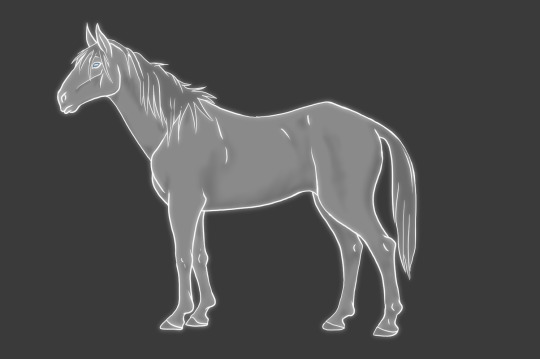
Instead, it was... off. like trying to draw a horse from memory.
The waist tapered in.
The legs were slightly too long or the torso slightly too short, probably both.
The ears were Triangular.
The head wasn't quite right- Too narrow and the jaw wasn't heavy enough.
The tail was too long and arced unnaturally away from the body.
The neck arched.
The nostrils were too high and close
The mouth too long.
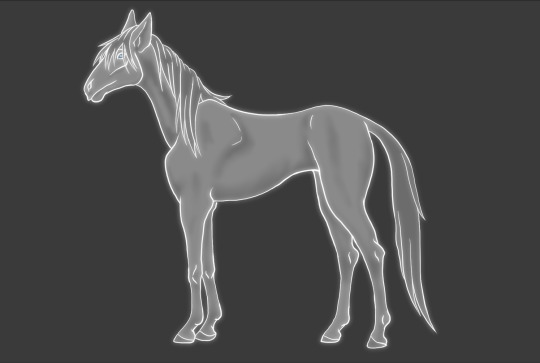
Whatever this is, a Mustang it Ain't.
I watched it from the back seat as it sniffed around the front of the van, curious with about the side mirrors. It moved around the van, nibbling experimentally on the front door handle. It came up to the side windows, sniffing like a dog, and it's breath didn't fog up the glass.
Finally, it came up to the rear window, which was rolled halfway down to let the fall night air in. Not even half a pane of glass and two feet of air between us, and I could clearly see it's bright blue eyes.
Horses have Elongated pupils to give them a wide field of vision, and eyes that rotate sideways in their sockets so the pupil remains parallel to the ground. Rather creepy to watch, especially the ones with blue eyes.
A real horse that was curious about the interior of the van would have come up to the window more or less sideways, and looked at me with something like this:
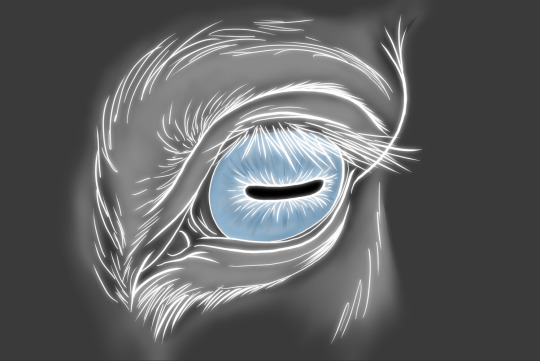
Instead, the damn thing walked up and faced the back window head on, staring back at me with this:
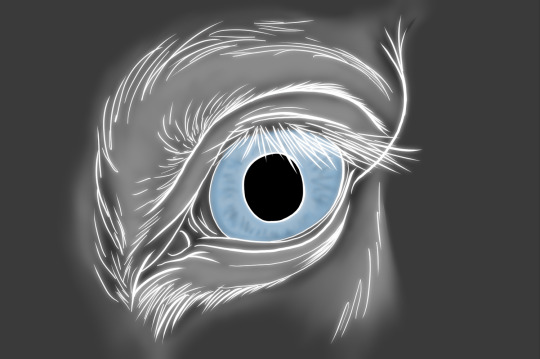
I'm not sure how long we watched each other like that, eyes locked. My eyes burned. I couldn't blink. My mouth was dry. I couldn't swallow. My throat began to ache. I couldn't make a sound. My skin began to twitch, like I was severely dehydrated. I couldn't move. My lungs burned. I couldn't move. I couldn't move. I couldn't move. I couldn't move.
Something was touching the side of my hand on the seat next to me. It's my water bottle.
The realization must have broken the terrible paralysis in the lower parts of my brain first, because by the time I consciously realized I could move again, I was already flinging my water bottle out the window at it.
The top was open, and splashed out the window at the Mustain't.
I've never heard such a scream out of an animal. Something halfway between the sound of unquenchable rage vibrating in someone's chest and the way rabbits cry out to God when the dogs catch them.
It jumped back, pivoting away from the van, snarling at the water bottle. I don't think you're supposed to be able to see All of a horse's teeth at once, no matter how angry it is.
I watched it run into the night for some distance, it's pale body visible against the black sand and the dark gray shadow of the ancient volcanic cone it was headed for.
When the blood stopped pounding in my ears, I could hear the bats again.
I debated leaving right then, but I didn't want to get out of the van with that thing in the area, nor litter by leaving the water bottle out there. I also had the awful idea that if I left now, it might somehow be able to follow me home. I ended up staying up three hours to watch the sunrise, shaking and trying to figure out if I'd woken up from a vivid dream, if my meds had stopped working, or if that had really happened. I didn't dare move until I actually felt the temperature rise, before stepping out of the van to grab the bottle. I had my camera ready- I was still using a DSLR back then- to take pictures of the hoofprints, to show how close it had gotten to the van.
No hoofprints.
Beetle tracks in the soft sand around the van, and the clear foot-and-wing prints of a bird that had hopped around then taken off. But no hoofprints.
I went over the entire campsite with the tent broom, to make sure I removed every scrap of evidence I had ever been there, including my footprints, grabbed my water bottle, and drove the three hours back back to Glendale, then decided to do seven more hours of driving to Moab, Utah just to put more than 500 miles, the state line and at least nine things that could be considered "running water" between me and the Mustain't.
-
I still have that water bottle. It has a dent in the bottom from hitting something, but that could have happened at any time. Strange thing though. I can't drink that bottle dry. I'll have it on me, drink whatever I've put in there- water, juice, iced coffee- and eventually feel like I've drunk the whole think and that it's empty. But I open it up and it's still at least a quarter full. I drink that. I get thirsty. I open it up again. ...and there's always a mouthful left.
Not sure what the side effects of drinking from a bottle cursed by a Mustain't to always have some left are, but it lives in the Emergency Breakdown Kit in my car now, just in case I meet another one.
---
(I'm a disabled artist and make my living telling stories, please consider supporting me on Ko-Fi or Pre-order the Family Lore book on Patreon)
#Family Lore#scary stories to tell in the dark#or out camping#Horses#sort of#The Mustain't#long post#trypophobia#I know these are usually funny but this one is spooky
12K notes
·
View notes
Text




sketch dump bc i cannot get my mind off this fic + comic abt the fallout of shifter!stan verse jurassic park adventure from that one ask bc i would die and kill for dark lord's emma may. also stan just... mossing himself and glomming onto ford? peak.
the scrapbook. can i talk about the scrapbook???? the fucking love and care that ford put into making it??? for stan???? for stan his brother stan that he loves so much he made that????? stan trying out a moustache for like. a day and everyone hating it.
i love how sopping wet baby shapeshifters are they're like weird gross little wet cats and i want to smoosh them gently.
#gravity falls#dark lord shapeshifter au#stan pines#ford pines#emma may dixon#shifty gravity falls#completely unrelated but drawing baby shifty makes me want to post my dnd bugbear lore#theyre so fucked up and weird bc i made them that way!!! lil moth bears of all sorts#baby stan trying to make him and ford match better but ford saying 'put it back' is so!!!!!! augh i cry every time#but like imagine if he'd have let stan keep them that way#'honey did both our boys always have six fingers?????'#“as long as it's not actively killing them i don't know and don't really care”#maurice in the next building over mashing their face into a pillow and screaming bc STANLEY PLEASE WHY ARE YOU DOING THIS#YOU'RE GOING TO GET CAUGHT#shapeshifter!stan
300 notes
·
View notes
Text
Indulging myself with more angry soundwave and also jasterwave don't mind me (I NEED to see this man LOSE IT)

BLASTER!! JAZZ!! WHAT DID YOU DO. Pissing of your stressed, overworked wife smh 😒
Timelapse (it's SO LONG HELP...):
#a little lore abt this drawing.#i started the sketch at home while i was getting ready to go out#then i started the lineart at home .and continued it in the car.#DID THE LINEART WHILE AT GREAT AMERICA. (i got lost 15 minutes before closing btw. which is why theres a long ass pause in the middle#of the timelapse. srry abt that)#and then i colored it in the car. and finished it just now.#so that was. fun.#anyway.#jasterwave#soundwave fanart#soundwave#tf#fanart#transformers fanart#transformers#jazz tf#tf blaster#soundwave tf#i REALLY like this way of shading chat....i might keep doing this#(<- code for i am gonna keep doing this)#my art#art#digital art#ibispaint art#blastwave#soundjazz#jazzwave#jazzblaster#two extroverts always stressing out their dark mysterious introverted wife smh....someone get this girl a paid vacation and a babysitter...#i feel so nauseous irl rn help
166 notes
·
View notes
Text
@octdl-lee
Random captive TDL au lore dump and some behind the scenes stuff since you asked so nicely :]
Dark in captivity







victim did use dark as a way to train and get the mercs and him used to the box



victim and agent (i would probably explore their dynamic in this au also, mitsi would haunt this narrative because yes)



some behind the scenes things


additional art



#alan becker#animator vs animation#ava#ava tdl#ava victim#captive tdl au#long tag warning#dark is going to have some dog/caged animal symbolism and machine symbolism#TDL is very much a problem captive also very annoying one at that#you can blame the high security one him since his constant escapes helped rocket corp to tighten their security#victim is definitely insane and he will do some incredibly messed up stuff in this au#the machinery on agent is supposed to look like it is slowly consuming him like some kind of infestation#agent has some issues as well and will be an enabler for victim#victim and agent's relationship will get some attention in this au but the main plot will still revolve around chosen and dark#chosen and dark's relationship is a lot more complex so i won't bother to summarise it all since i don't really want to spoil it#TSC will receive a bit of attention since he is still very much tied to the plot of ava#tsc does have a split personality like an alter ego that takes over when he is in danger#i dont think i would really touch on the colour gang since i think it would make the story too messy#i do have most of the story already planned out#it is just the part leading to the ending#every weapon and tech in rocket corp was tested on TDL#in a way he did help with the destruction of chosen by helping rocket corp to improve their tech by being their test subject#fulfilling his code in its own twisted way#btw the additional cage in his containment area is to temporarily hold him during the box maintainence or upgrades#it is also the same type of cage that TSC is kept in currently#the box prototype that TDL is in would probably have a different name like 'the cage'#the bars of the cage is electrically charged and it also resembles a dog cage (dog symbolism)#there won't be too much about dark during his captivity since it will be more about how it impacted the relationship between him and chosen#i would probably start posting more random lore bits every now and then between comics#i hope i stop getting side tracked when working on this au
159 notes
·
View notes
Text
What We Get Wrong About Dark Sonic

I find Dark Sonic incredibly interesting.
I’ve said this before, but Dark Sonic represents an overflow of Sonic’s negative emotions, the ones he usually suppresses: anger, sadness, and fear.
However, many people believe that Dark Sonic is somehow a betrayal of Sonic as a character (even Ian Flynn, reportedly, but I’ve yet to see an official source). Sonic is meant to be a beacon of optimism. Sonic is meant to be the pillar of hope when all else fails. Sonic is meant to be the last one standing, no matter what.
In this sense, sure, Dark Sonic contradicts the notion that Sonic is “uncorruptable,” but I think that depends on how we define corruption.
I see it two ways:
1) Corruption by way of losing faith, through dishonesty and fraud. 2) Corruption by way of a forceful shift from one state of being to another.
In the first sense, corruption occurs when someone’s paradigm is shifted through lies, cheating, or manipulation. It’s a conscious mental shift. In the second sense, corruption occurs when something (or someone) is co-opted and changed without its will or influence, like data corruption, or a shift in the meaning of a word or image. It’s a literal, physical and/or metaphysical shift.
There’s a saying that floats around the fandom that says, “Shadow is just ‘Sonic, if Sonic had one really bad day’,” and I think that makes sense. Shadow is jaded and cynical because of how the world has hurt him, but he still wants to do right by people—just like Sonic. What separates Sonic from Shadow, however, is Sonic’s tenant optimism and positive paradigm. Without those differences, Sonic has endless reasons to be as cynical as Shadow, or even more so.
So, Sonic doesn’t let himself feel those feelings for very long, and especially not when other people are around. He pours everything into a clean, neat bottle, with a tight screw-on cap, right?
What happens when something tampers with that bottle?
Dark Sonic is a forceful corruption of body but not of mind. Let’s talk about it.
How Dark Sonic Works
What I think people misunderstand most about Dark Sonic is that it’s not an intentional state of being. It never was.
Dark Sonic is the polar opposite to Super Sonic, which is achieved when Sonic harnesses the positive energy of the Chaos Emeralds. If Sonic wanted to harness the power of the emeralds for the wrong reasons and his heart accessed the negative energy rather than the positive, he could possibly bring about Dark Sonic willingly. This, however, would likely never happen because that is the betrayal of Sonic’s character that everyone worries about.
That said, the only reason Dark Sonic ever appears is because of a mix of Sonic’s pure rage over Black Narcissist physically assaulting Chris and Cosmo and the presence of hundreds of the Metarex’s fake Chaos Emeralds, which possess an aura clearly shown to impact Sonic and make him ill.
Sonic’s first interaction with negative Chaos energy from the fake emeralds is filled with discomfort and even disgust. Sonic reacting to the negative Chaos energy poorly is critical, as it showcases that it’s seeking him out, not vice versa.

When Sonic was as triggered as he was, the negative energy from the fakes harnessed his emotions and corrupted him. It was a complete, freak accident.
This situation is very similar to Darkspine Sonic, the in-game equivalent to Dark Sonic from Sonic and the Secret Rings. Darkspine Sonic only surfaces when Sonic is severely triggered after Shahra starts to betray him, Erazor Djinn murders her (she sacrifices herself for Sonic), and he sees Erazor Djinn’s final form about to destroy the storybook world. In his shock and anger, the Secret Rings of Sadness, Rage, and Hate target him, painfully turning him into Darkspine Sonic. Once again, external energies corrupt him at the height of his emotional vulnerability.
Sonic never seeks out the negative energy of the Chaos Emeralds because his heart is good. When the negative energy seeks him out in such overwhelming waves, it corrupts his abilities, alters them, and pulls them out to play.
But—
If it’s simply a matter of fake Chaos Emeralds, then why can Sonic use Tails’ fake Chaos Emerald in Sonic Adventure 2 without any problems? I posit this to the fact that Tails might have a better understanding of the balanced nature of the Chaos Emeralds (in that they are powered by both good and evil), while Eggman and Dark Oak have only ever used (or desired to use) the Chaos Emeralds for evil.
Recall Eggman’s laser at the beginning of Sonic Unleashed and Perfect Chaos in Sonic Adventure. Both uses of the chaos emeralds drained them of their power—their negative power, that is. (Albeit through different means based on the lore of each game), Sonic is still able to restore and harness the emeralds’ power because he relies on the positive energy of the emeralds. As intelligent as he is, I imagine that Eggman (as well as the Metarex) has a hard time replicating the intricate nature and balance of the Chaos Emeralds because their hearts are filled with hatred and turmoil, so unwilling to heed the perspectives of others. The power is there, sure, but not the heart.
~Chaos is power. Power is enriched by the heart~
Tikal's Prayer
I think the difference between Tails’ fake emerald and every other fake emerald we’ve seen in canon is marked by the fact that both Eggman’s and the Metarex’s fakes disintegrate after excessive use (i.e., Chaos Control), but Tails’ fake remains intact.

The Metarex's emerald disintegrates upon excessive use
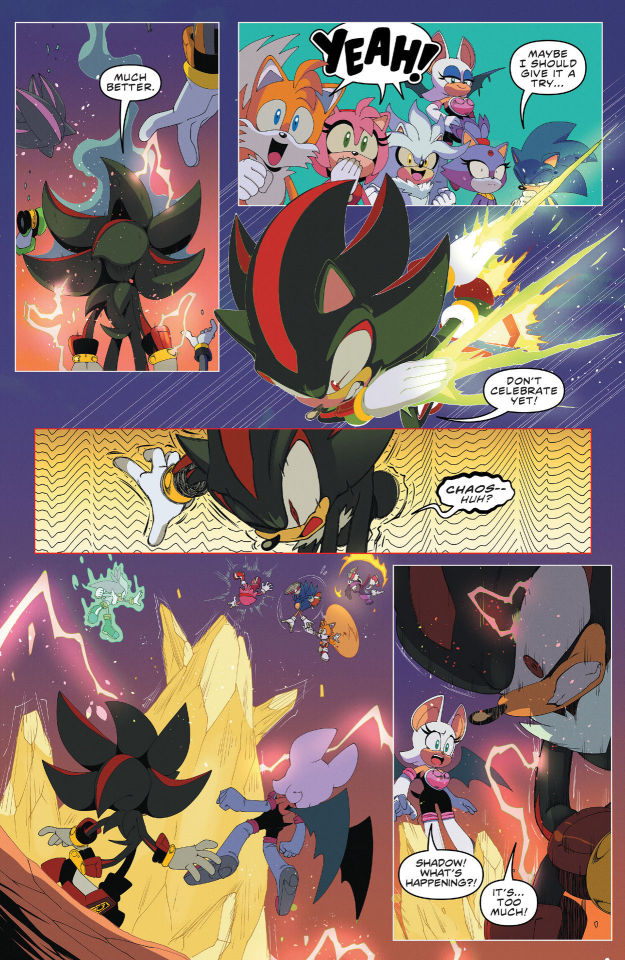

Eggman's fake emeralds can't hold their form upon excessive use
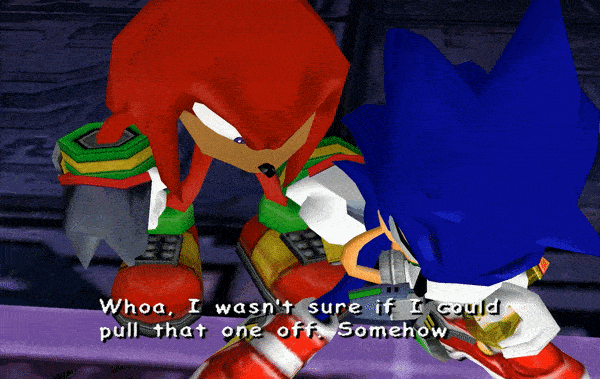
Tails' fake emerald is intact and ultimately used to stop the Eclipse Canon from firing
In short, Tails’ emerald is simply a better fake, more accurate to the originals.
also, I refuse to talk about how dumb it is that Sonic was able to use a fake Chaos Emerald to do Chaos Control for the first time. However, it is canon, and therefore relevant to my point.
Another key problem cited in Sonic X is just how many fake emeralds there are. One emerald pales in comparison to hundreds. Sonic feels all the latent negative energy consume him because that energy is a corruption, itself.
It’s not that Sonic gets so angry that he just gives in to darkness, it’s that darkness captures him when he’s in extreme emotional distress and his guard is down. Dark Sonic is the result of negative, unstable, potent Chaos energy clinging to him, using his latent Chaos powers as a vessel when he least expects it and, thus, is powerless against it.
I think I can best prove this by contrasting Dark Sonic with Sonic’s other intimate encounter with darkness…
Sonic Unleashed, Dark Gaia, and the Werehog
I’ve spoken at length about this game and this specific scene, already, so kindly forgive my hyper-brief summary this time around!
When Dark Gaia’s “weight issues” cause its essence to disperse around the globe, many people fall influence to Dark Gaia’s despair, losing faith and hope in the world. Nothing like the influences of Chaos energy, but enough of an influence that much of the world feels it. A core aspect of the game’s plot is that Sonic, distinctly, does not. In the cutscene No Reason, Sonic asks Chip why he stays the same despite the darkness inside his heart while so many others change at night. Chip answers simply, saying that Sonic’s too strong to lose himself and that part of his good will is because he never doubts himself, even when he’s on his own.
The difference is that while Sonic undergoes a physical transformation, he never loses faith or gives up hope—made especially clear by the fact that Professor Pickle, once as hopeful as Sonic, eventually does lose hope.

Also key to note that Amy also never loses hope.
Unleashed is just another fun, high-stakes adventure for Sonic; there’s never a moment where he’s aggressively triggered by something or when his personal morals are ever tainted. Irritated, maybe. Flustered, even. Never at a loss. The closest we see Sonic come to this is when he loses the werehog form to Dark Gaia before the final battle. He falls to his knees, worn and exhausted, and tells Chip to run because he doesn’t want him to get caught up in the mess. Yet even then he’s not giving up.
That’s why Sonic’s heightened emotional state is so important to the conversation. When Sonic’s will is intact, he’s much stronger, but when he’s triggered by something and his defences are down, it’s much easier for corrupting forces around him to take hold.
Mind over Matter
Even with the parameters for Dark Sonic’s appearance established, something that stands out to me about Sonic’s encounters with dark energies, and something I see as additional evidence that Dark Sonic is only a literal, physical corruption and not a corruption of his paradigm, is that Sonic is still in control of himself—to an extent.
Even as he seethes in his amplified rage, Dark Sonic never inflicts harm on the innocent. After Gold and Silver are destroyed, it’s not expressly clear if Sonic intends to stop or fight Black Narcissist, but Eggman implies that Sonic was fighting Gold and Silver until there was quite literally nothing left. Sonic was given a target to attack, and he kept his focus there, even when other enemies presented themselves.
This also goes for the Werehog and Darkspine Sonic.
He also has the mind to listen to reason—from Eggman, of all people—and stop when it’s clear that he’s finished what he set out to do. Sonic channels his anger to where it needs to be, and it’s clear that Sonic’s moral code and paradigm on life are thoroughly intact.

The only thing that changes is that he’s no longer imposing his usual limits. Sonic is stupidly powerful, even without any power ups. If he ever wanted to kill Eggman, he would have by now. If he ever wanted to kill anyone, he would have by now (and technically, he has).

Sonic throws Erazor Djinn's lamp into a pit, never to resurface, effectively trapping him and ending his livelihood indefinitely.
However, Sonic holds back because he doesn’t want to be an arbiter of justice—he doesn’t want to deprive someone’s chance to be good unless it’s been clear that they cannot be redeemed.
Why I Care About This
It is no secret that I believe that Sonic is a highly emotional character—far more emotional than many give him credit for. It bears repeating that Sonic’s emotions are very big and can be cataclysmic when left unchecked…
…but that’s just part of growing up—growing up as a hero and, damn it, even just a kid.
Dark Sonic isn’t a case of Sonic giving himself to darkness, nor is it a perversion of Sonic’s character. It’s an energetic, chaotically-charged version of Sonic when he is at his angriest—and even then it’s not enough to change his morals or make him lash out unjustly.
Dark Sonic is cathartic, in a way, and I definitely think it deserves its place in canon.

#sonic the hedgehog#sonic#sth#sonic character anlysis#dark sonic#in defense of#dr eggman#eggman#sonic x#sonic unleashed#sonic adventure#sonic adventure 2#sonic and the secret rings#chaos emeralds#chaos#perfect chaos#shadow the hedgehog#idw sonic#sonic idw#sonic idw spoilers#japanese sonic x#long post#:)#sonic the hedgehog needs a hug#sonic lore#sonic canon#molinaskies#ソニック x#ソニック・ザ・ヘッジホッグ#ソニック
2K notes
·
View notes
Text
Since my friend is rewatching Reign Storm, this post is about that episode! Specifically, Pariah's backstory, which fits here because Skulker was the one to give the exposition.
Transcript: "It was many years ago. Before you. Before me. Before most of us. His name was Pariah Dark. And he ruled the Ghost Zone. He was a ghost of such power and magnitude, only he could control the [entities? energies?]* contained within the Crown of Fire and the Ring of Rage. When wearing both, he could do anything. Until a group of powerful ancient ghosts banded together in a last-ditch effort to defeat the King. By locking him within the Sarcophagus of Forever Sleep. Or so we thought."
Facts that this reveals:
Skulker didn't appear in the Ghost Zone until after Pariah was defeated.
There may be entities within the Crown and Ring, but Skulker's voice isn't entirely clear on that part.
There is no such thing as "The Ancients." It was merely a group of powerful ancient ghosts- i.e. old ghosts. Since the story takes place a long time ago, it may just be a group of powerful ghosts. The entire concept of The Ancients is fanon, not canon.
Before Pariah's defeat, his Keep was at the top of a hill on a large landmass, with many other fortresses and walls around. After he was defeated, the rest of the landmass crumbled, leaving only the Keep and the small bit of rock it was on.
*It sounds way more like "entities", but "energies" makes more sense.
#danny phantom#skulker#pariah dark#fright knight#reign storm#dp lore#the ancients#this mention of pariah dark being before skulker is the one hint we get at how long skulkers been in the zone!#also the way skulker says the story very much gives the energy of an oral history that's been repeated and passed down verbatim for years
155 notes
·
View notes
Text
things we know about Silver’s future and backstory lore
he fought and struggled for half his lifetime through the disaster future filled with despair(he fought demons and disasters like fire tornadoes since he was 7)
he looked for the cause of the disaster his whole life but no one he talked to could answer him(which is why he listens to Mephiles)
psychic powers are common in Silver’s future
(unconfirmed) Silver’s gloves, boots and cuffs were made by scientists with spiritually resonant metal from an ancient civilization that could strengthen and stabilize mental abilities. Silver’s Psychocuffs amplify his psychic powers and give him greater precision with them. they are a constant reminder of his duty and the sacrifices of the people who created them.(Silver’s gloves and cuffs have the symbols found all over Sky Sanctuary)
he killed Iblis over and over again because it was the only thing he could do to try and fix things
Silver believed in restoring the blue sky when no one else did
Silver ate apple flavored calorie bars and ration foods and had bandages. we don’t know what else he had in the apocalyptic future
Silver is a feral warrior because and that’s why he always has those aggro expressions even when he’s playing sports. he’s got crazy pain tolerance and is ready to bite your face off if you surprise him in Generations
Silver is naive and innocent and doesn’t know or get certain things because he’s from the hell world future(Heneryism)
he loves nature and people’s smiles so much because the world was full of disasters and black skies and people lived in despair/without hope
some really complicated stuff with Blaze happened that hasn’t really been explained yet but Sonic Rush comes before 06 and Blaze wasn’t from the future according to some of the writers and the Sonic Channel timeline. Silver and Eggman Negative are from the future and Blaze is from her dimension
because of 06's ending Silver’s future was restored but he doesn’t remember how(he doesn’t remember 06)
after 06 Silver gets to live in the peaceful future he always wanted with blue skies and smiles and he thinks Sonic’s time is dated(unless ESP Silver is a real thing then 06 and Rivals Silver are different characters and things would be even more confusing)
so far they've mentioned robots, pumpkin dumplings, super trains, cars like the lightron, extreme gear made with special future metal, a camera that turns people into cards in Silver’s good future
Silver’s good future is called the blue sky future


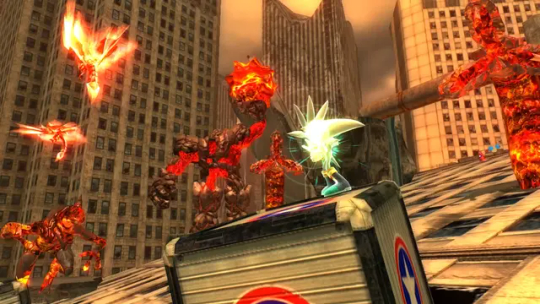





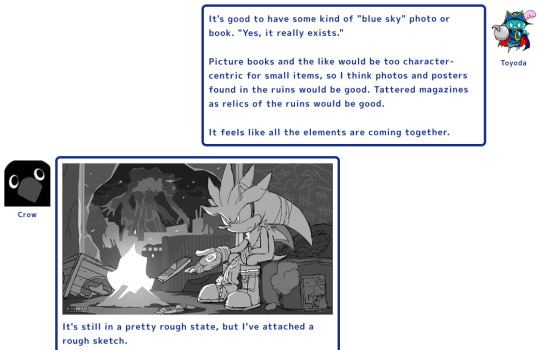








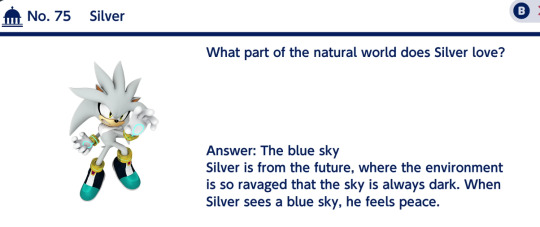







#sonic the hedgehog#silver lore#silver the hedgehog#blaze the cat#amy rose#espio the chameleon#eggman nega#iblis#mephiles the dark#tails#sonic channel#sonic 06#sonic rivals#sonic generations#sonic colors ds#idw sonic#mario and sonic at the olympic games#i thought this post would be shorter#silver is complicated#sonic lore#long post
78 notes
·
View notes
Note
currently thinking about how dark enchantress is technically WLC and how maybe her weakness is still PVC deep down
It definitely could be true.
While I was writing the chapters for my PureLily fic, Love is like a Poison , I found myself pondering about it in my free time lol mainly to get a better understanding of WL's character
Idk if I have said this here before but I see White Lily Cookie and Dark Enchantress cookie as Kagome and Kikyo from Inuyasha as their characters resemble eachother perfectly.

Just like Kagome and Kikyo, both are the same as they share the same soul but with two different halves and beings.
When their souls split and DE was born, they got divided in two halves.

Just like Dark Enchantress Cookie's birth was through a tragic event and basically the "death" of White Lily Cookie where she split in two

As shown in her gacha animation too

Kikyo's tragic "death" is what caused the birth of her reincarnation

But also a hollow version of her when she was brought to life again unfairly.

Just like the Shikon Jewel which shall never again choose her or shine for her in her rebirth, the light of freedom shall NEVER shine for DE because just like Kikyo, upon death both of them were reincarnated as former shells of themselves, born with only resentment, revenge and hatred towards the world, the last feeling they felt before they died.
WL got to keep the love and kindness part of her soul while DE got born with her dark hatred, jealousy resentment, angry and regretful side. Just like Kagome got born with love and empathy while Kikyo got born with anger and resentment because of how unfair life had been to her previous to her "reincarnation" (Inuyasha fans will know)

Just like her, DE is also more than happy to get rid of her "other half" as it is the part she is missing and she.... doesn't want to acknowledge that

She doesn't want the reminder of the pain when she went through at all.
Just like DE, she (Kikyo) lived a miserable existence as she couldn't accept the fact that Kagome (who is basically her reincarnated in modern time, sharing her soul and heart) exists and Inuyasha (whom she loved) still loved her (just like she loved him) and wanted to reach a conclusion. She continued to hate him, but still kept reaching out to him. She didn't get liberated until she found closure from him.
I see White Lily Cookie and Dark Enchantress Cookie's character in the same light because underneath all that hatred and anger, DE, as much as she likes to pretend she doesn't care, she cares a lot.

Which is evitable with her question here.
Just like WL, who asks the same question.

Despite everything, DE is still what WL is, but just a former shell of it for she only got her hatred while WL got to keep the love and kindness she possessed at heart.


At the end, DE is merely a shadow of what WL is and would forever be incomplete without her. Deep at heart, despite the anger and resentment, DE is still is doing what she feels like is in the best interest for Cookie Kind. Not to attain world dominance, not to get all that power for herself but trying to "fix" the world in a way she feels is right


All of these wars and atrocities? All of this is still for the "help" of others.
Mainly because Dark Enchantress Cookie still cares.
She is still that scared White Lily Cookie with anger and fear clinging her heart as she fell to her ultimate doom.
That girl who thought she can change the world single handedly.
The girl who failed.
The girl who lost her life in the process and is angry about it.
The dead girl still saying "Only I can offer a path to unity."


Just like Kikyo, who also seeked to "fix" the world after she got reincarnated with just hatred

DE is still trying to do what's best for everyone even if it means casualties and hurting everyone in the process.
Something WL, being morally grey, also has done to reach the "truth" (not this severely ofc cuz she still held love and kindness, smth de lacks) but did all the same and perhaps even continues to do so without realising. But she recognises this flaw and is trying her best to fix it.
This is why, I can confidently say Dark Enchantress Cookie has deeply suppressed feelings still for Pure Vanilla cookie and vise versa.
Because again underneath that soul less shell, she still is an extension or perhaps a part of WL, who still carries similar feelings and sentiment over things she cares about.
And no matter what she tries, it keeps showing.
White Lily Cookie is consciously aware that Pure Vanilla Cookie is her major weak spot. Something which even Shadow Milk Cookie catches on very quickly.
Even Dark Enchantress cookie is aware that perhaps only Pure Vanilla cookie who, as much as she'd like to discard her past, continues to be someone she sees as a threat because he can stop her, not just via power but via being himself
And it shows, over and over again.

"Especially you"

Even back when she met him all over again, she's like "So you finally admit you were an idiot aye?"
When PV tries to talk about it, she goes


She is amused and curious. Because she does know this guy was close to her. She knows his deal, she is interested in hearing his side even though frankly she got no reason. She still has an interest over him.
But she recognises this instantly so she doesn't even let him speak lol

Because while she is interested, she is still angry. As evidenced here:


The interesting thing here is, she glares. Because she still recognises that something about him still makes her feel ...weak
Which is why her next question was this

She questions her weakness despite Pomegranate never even mentioning anything about it and just saying "as long as pv is here, the echoes of the past will continue in this castle"
Which is why, DE inorder to get rid of this, tries to kill him lol because she knows Pomegranate is right and that she won't be able to do anything if PV just keeps being himself because no matter how hard she wants to throw away her past, that strange pull for him would never go because he is a major part of it.
What better way to stop making yourself feel bad but by simply getting rid of the thing causing that hurt especially when you're in an eternal cycle of anger and resentment and are incapable of thinking rationally emotion-wise?
She is still angry at him for sealing her and if we go deeper, not getting/understanding her. Which ultimately lead to her doom and cause DE because like I said, underneath all those layers, WL still is alive in DE, in a form who is angry at PV for not understanding her even before anything happened. Something which ultimately led them to splitting paths as even PV admits, he didn't get her and which is what led to both of realising that they gotta part ways, leading to WL's expedition to beast yeast for searching the truth and for PV to stay back and help crispia and his kingdom.
Both did things for helping others.
Their goals aligned but at the same time, they didn't.
Because neither of them got eachother.
Because unfortunate timing.
PV valued his Kingdom more than searching the world with her for a truth they may never find.
This is why when she "meets" him again in Creme Republic, she is almost disappointed at him lol


To the point you can interpret it as "You are still an idiot and you are talking to me?! Stfu"
Just like she was disappointed back at banquet because despite all this time, he has still not seen the "error" in his ways according to her.
He still didn't understand her vision.
This is why, this is exactly why DE is the way she is to him.
She is still deeply affected by him. Even if she doesn't admit it, she still cares a lot. She still has deeply suppressed feelings for him which make her question herself even when literally no one on earthbread is capable of doing so.
She doesn't understand these complex feelings because she never processed her anger. She is permanently incapable of processing these feelings because her other half got that part and now she is merely a husk of what she was.
Just like Pure Vanilla Cookie still questioned his feelings for White Lily Cookie (whom he knew had become Dark Enchantress Cookie), Dark Enchantress cookie definitely questions hers but in a way she is capable of mentally and in her own way.
Pure Vanilla Cookie is what Inuyasha is to Kagome/Kikyo. He recognises the soul of White Lily Cookie even when she can't find it out because he truly loves her. He didn't just love her, he fell in love with her soul. He recognised it was WL in his final moments of the Dark flour war as his eyes went wide which is why he sealed her instead of killing her and along with that sealed his own memories because he couldn't bear this anymore.
This is why when told again that de is wl, he accepts it relatively fast because he knows, he knew and was in intentional denial because he didn't want her to be that.
This is also why he is the one approached by the light of freedom because it also knows that only he has the ability to know the true WL and recognise her being.
This is also why he is more than happy to get WL despite her being half alive to the point of him being willing to die just to get her back because he loves her soul and he wants that part, the one whom he fell for, come back to life and wake up.
This is also why again and again back when he didn't know the entire debacle of WL and thought she is gone for good in exchange of DE, he tried to explain her over and over again that there still was time and she can come back if she wants because he didn't want to seal her, not when he clearly recognises that it's her, it's still the same soul he fell for but now against him.
This is why he happily embraces WL back when she is alive again because he realises that she and DE are not the same despite being the same soul.
Because he fell for WL and not her but he can still/might have residual feelings because at the end, they're still part of each other but he'll always love WL more because DE and WL are no longer the same. But he will definitely always have a spot for DE too cuz that's a fragment of WL too. A part of her too.
So does that mean DE has feelings for PV? Highly possible because it's clear that she's still drawn to him and what he has to say. She still holds him in high regards despite what she likes to admit to herself.
So yes, it is very possible that DE still has deeply suppressed feelings for PV just like he did for her once (before WL woke up) but she would NEVER voice them because caught in a cycle of eternal anger, pain and resentment, she has lost the ability long ago to process these emotions.
Just like Kikyo continued to love Inuyasha but couldn't say it out loud despite her evil birth, despite everything, still continued to subtly show so as she became incapable of love in her new unfair "birth", DE shall always remain this tragic character with an unfair fate and life incapable of emotions and feelings other than hatred.
This is also why, these 3 shall always remain my favourite characters as WL is not a Mary Sue, she is a deeply complicated, complex character who deserves all the love she gets along with PV.
#cookie run kingdom#Crk#crk lore#Lore#Cookie run kingdom lore#pure vanilla cookie#white lily cookie#dark enchantress cookie#dark enchantress crk#Cookie run#Inuyasha#kagome higurashi#kikyo#character analysis#Pure vanilla cookie character analysis#Dark Enchantress cookie character analysis#White Lily Cookie character analysis#Purelily#pure vanilla cookie x white lily cookie#pure vanilla x white lily#Crk lore analysis#Pure Vanilla Cookie x Dark Enchantress cookie#white lily x pure vanilla#Pure Vanilla x Dark Enchantress#Asks#Im sorry for this long ass analysis 😭#darkvanilla#Fixed a few typos!! Sorry for them folks idk how light of freedom got changed into truth... autocorrect is weird af at times#I wrote this after I took a short break from writing chapter 9 💀 chat am I sane 😭#Long post
86 notes
·
View notes
Text
Fun Facts about Fiance to a Star
Lore/relationship drama of Phantom family and those connected to it, this time. Long post, be warned.
It all started like a fairytale - Madeline Walker was the fairest in all lands, beauty and grace, genius magical prodigy, skilled with a sword, kind, loyal, and fierce. When she first came to AMITIE, young and full of stars in her eyes, Clockwork had warned her not to dig too deep.
She did not give his warning much thought.
Over the years, a lot of men tried to win her over, but she declined all of them. Vlad, who had fallen in love with her at first sight, decided to be smarter than most and claimed the place of her best friend, hoping that later she would notice him. Madeline did not. Instead, she had fallen - both literally and metaphorically - all over Jack Fenton, who, unlike all others, had never given much thought to her beauty or genius. Jack only saw a girl who was just as interested in studying otherlings as he was.
The three of them together - Maddie, Jack, and Vlad - had created lots and lots of trouble during their years in AMITIE. It was Jack who once overrun the fifth floor by a giant plant spirit - a weave of a charm gone wrong. Even now, years later, it is not recommended to bring any plants on the fifth floor hence they may come to life. It was Vlad who accidentally forced a blessing of Nocturn over a whole class of White Golds, and Clockwork had to spend a week trying to release them from their forever sleep. It was Maddie who engraved an explosion charm into her staff, which backfired splendidly a month later - the ceiling of the cafeteria still has a few scorch marks from that day.
And it was all them together who created the first unmarked door.
It was a breakthrough, a path to the Other Side, an accomplishment like no other. For the first time, humans could come to the Other Side at will.
Unfortunately, it also meant that otherlings could come into the Mortal Realm just as easily. But nor Maddie, nor Jack or Vlad knew it then.
Excited at the successful experiment, the working door to the Infinite Lands, Madeline proposed to Jack then and there, and he, overwhelmed by his happiness from all sides, agreed instantly. Vlad was forced to accept it - he did not like it, but Maddie made her choice, and he could not convince her otherwise.
Just a year later, Jazz was born. And, by sheer coincidence, the second unmarked door had appeared, not in the research labs in the underground floors, but on the eighth floor, by Vortex's classroom, without anyone noticing.
It was not long until the Darkest Pariah had noticed these new paths. And, when he went through out of curiosity, what did he find? A place full of mages of all sizes and shapes. Ancients - his subjects - teaching humans of the ways of magic. And a charming maiden with hair as bright as fire and a wicked grin on her lips, with magic like no other. It must have been destiny.
Yet, when he asked, the maiden turned him down, just like she did with every other man. She claimed she was already married. Pariah did not understand - her soul was untied, which meant whatever marriage she was speaking of has not been official in his understanding. So, finding no other way to claim what he already thought of as his, he stole the love of his life and brought her to the Other Side.
She fought him. Again and again, every day, until Pariah saw no other way than to simply charm her into accepting him.
A year later, the Wandering Star was born. Maddie insisted on him having a human name as well, but Pariah never liked how 'Daniel' sounded.
Meanwhile, as Pariah was enjoying his play-pretend at a family, back in the Mortal Realm, both Jack and Vlad were going insane with worry. They kept searching and searching for Madeline, first together, then separately after a fair share of arguments between them. It was Vlad who had finally found her through many trials and dangers. In Pariah's castle. With a kid.
Long story short, he stole her away, together with Danny, and brought them both back to the Academy. The charm Pariah put Madeline under fell just as they got to the Tower, and Vlad, in his frenzied and panicked state, confessed to her at that moment. He told her he could protect her and do it better than her oaf of a husband, he would accept the half-otherling kid, he would do anything for her. He already did everything for her, he stood in the way of a burning curse that was guarding Pariah's castle...
But Maddie, overwhelmed by a sudden flood of memories that came back after Pariah's charm fell, pushed him away and ran to find Jack, leaving the heartbroken, cursed man where he stood.
In the next few years, everything seemed to go back to normal. The doors - each and every one that spawned over the Tower - were sealed and locked away. Jack and Jazz reunited with Maddie, and Danny was accepted into the Fenton family easily. Clockwork offered them to stay, to live in the Tower - if Maddie or Danny ever stepped out, they would immediately be found by Pariah. The Academy was the only place that was hidden from his gaze.
Danny grew and learned more and more. He met Tucker when he was five - the boy's family were magi-blacksmiths, and they moved to the town near the Academy to have access to its research and labs. Later, they both met Sam. She was undergoing a course of Trait control in the Tower since her familial plant powers were amplified by a blessing granted by Undergrowth. Sam bragged about a prophecy that spoke of her gaining unlimited power in the future.
Vlad, who disappeared shortly after Maddie's return - supposedly to gain control over the remains of the burning curse that were left in his body - came back when Danny was eleven. Yet, he didn't try reconnecting with Fentons, nor did he speak to Danny about anything. He buried himself in research and, slowly, merged in the background. Just another unfamiliar face in the crowd, another researcher in the Tower.
When Danny was twelve, he found one of the sealed unmarked doors. What happened next, everyone in the Academy remembered as the Time Catastrophe: when re-opened by a child that had way more power than he could control, the door did not lead him to a different place. Rather, it led him to a different time. Clockwork later explained it as a mistake caused by the fact he was personally mentoring Danny most of the time, so the boy must have unconsciously picked up a thing of two from him, from the Ancient of Time.
In any case, through that door came Dan. And it went... Not very well, but by the end of it, the older, different, wrong version of Wandering Star stayed in this dimension. After all, it was an accident that brought him here, and there was no way to send him back. Jack and Maddie offered him to join the family, of course, but the man declined. And, seeing that he was not the Child of King to the Other Side, not the one Pariah was looking for, Clockwork let him leave the Tower. He became a mercenary - a wanderer - and wasn't that ironic, given his name.
Everything came to an end two years later, when Danny turned fourteen. The Rift, a giant portal to the Other Side, opened over the Tower, and countless demons came through it. And, at the front lines of the otherling invasion, was the Darkest Pariah.
On his right side was Vlad and a girl who looked so much like Danny.
The demons, born over the years from Pariah's loss, grief, and anger, could not get through the walls of the Tower. Guarded by the oldest Ancient, it stood tall and protected by numerous shields the Ancients have created over the ages. Fentons were safe inside, but... There was no one to stop Pariah. The Ancients, bound by the Crown, could not fight the King, only defend themselves. So, in his attempt at luring the ones he desired out, Pariah sent the demons to towns and cities around, threatening to keep killing everyone they find until the Academy gives him what he wants. And he wanted Maddie.
When she heard about it, she knew she had no choice. One life over hundreds, maybe thousands of others, it was a simple decision. Yet, before she could make it, a child stood up in front of Pariah.
Danny, who cared for his mother and called Jack his father, despite knowing he was not born to him. Danny, who spent his life in the Tower, closed off from the wide world because of Pariah's obsession. Danny, with two friends by his side, an ice blade in his trembling hands and silver in his eyes that spoke of anger, of hurt, and of a burning desire to protect those he loved.
The Rift was closed only half a day after it was open.
Darkest Pariah met his end at his son's hand.
To the outside world, the Rift had been an unfortunate catastrophe caused and later handled by the mages of Academy. Only a handful of people - and the otherlings, of course - knew the truth, and none of them really wanted to share it.
Vlad, narrowly escaping death with the help of Dani, was made to stay at the Academy, where Clockwork could keep an eye on him. He never confessed it, but everyone was sure he's been the traitor who told Pariah of Maddie's and Danny's whereabouts.
Dani - Vlad's poor attempt at recreating Danny, the reasons for which he also never told another soul about - had spent nearly a year in Frostbite's care. At first, she remained loyal to Vlad as her creator, but over time, with the help of many talks with both Danny and Clockwork, she learned the whole ugly truth about everything that happened. Since then, she never spoke to Vlad and never returned to the Academy, spending her life as a free spirit and roaming the world.
Soon after the fall of Pariah, Maddie, who was now free to leave the Tower, decided that her life as a mage and researcher had come to an end and left it behind. Jack followed her, deeming his wife more important than magic. They offered both Jazz and Danny to go with them, but Danny could not leave the Tower yet - not because of someone or something keeping him there anymore, but because of the responsibility that fell on his shoulders after Pariah's defeat. He was the Heir now, the rightful Prince to the Other Side. Jazz stayed behind as well, for many reasons, starting with the fact she did not want to abandon her brother and ending with her own goals, most of which were related to magic.
Two years later, Clockwork had given Danny a scroll with a long-forgotten prophecy that tied him with one of the Gotham princes.
-------
This is the very brief run-through Danny's life before the events of Fiance to a Star. I skipped over a lot of details here, like how Sam's prophecy turned out, for example (short answer to that is pretty much 'unfortunate plant possession'). If you have any questions about other characters, feel free to ask them! Depending on how much I get, I might end up making a whole another post with answers.
Oh, yeah, by the way, about Fenton/Phantom. Fenton is Jack's last name, and, naturally, both Jazz and Danny have it. Yet, Dan and Dani technically do not belong to the family, so after Jack and Maddie left, Dani jokingly offered Phantom as a last name for Danny, Dan, and her. Since they are phantoms of each other, she thought it was poetic. The boys thought it was a great idea, and later, Jazz was also included in the Phantom family. It wasn't long before Sam and Tucker also started using it, so now they are a weird mix of friends and family that all go by one last name in certain circles (among otherlings, mostly).
#danny phantom#dc x dp#dpxdc#fantasy au#fic lore#pariah dark#maddie fenton#jack fenton#dan phantom#dani phantom#jazz fenton#clockwork#god this was long#i tagged this dpxdc but really its only dp here#except for last line#oh well#anyway this was fun#hope that makes sense#cork writes fantasy
202 notes
·
View notes
Text
The Long Dark Lore - The Complete Story of the Tales Trilogy - Tales from the Far Territory
youtube
#the long dark#tales from the far territory#the long dark lore#tld spoilers#survival games#toastybits#Youtube
0 notes
Text
I know I was joking when I said "Konrad Curze did not do enough things wrong", but as I'm getting deeper into the actual meat of his bibliography I genuinely feel like I'm staring into an abyss so dark it never even dreamed of the light.
Like holy shit. This is DARK. I know Warhammer 40k is grimdark and all, but this hits so much more deep and accurate than it has any right to. Almost suffocating in its hopelessness.

Suffice to say, this cannibalistic unwashed trainwreck is officially my favourite character. I'm kinda scared for myself, but hey, that's Night Lords for you I guess.
#am i reacting too hard? idk i feel it's warranted#i've not seen character lore so devoid of any sort of positivity in a long time#and i'm an asoiaf veteran#was absolutely horrifying#yet it is presented so rationally like yeah what did you think would happen?#like top notch horror writing curze's lil speech at the end#a lesson in darkness#warhammer 40000#warhammer 40k#warhammer#primarchs#imperium of man#konrad curze#night haunter#kurze#ian st martin#audiobook#curze a lesson in darkness
59 notes
·
View notes
Text
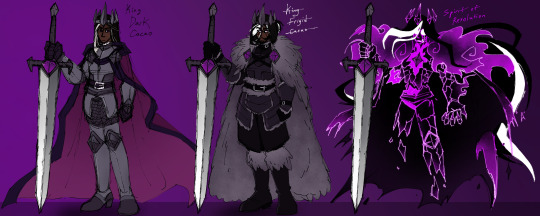
King Cacao, the leader of what remains of a splintered empire- of a safe haven capital in the heart of a land cursed into eternal winter.
#cookie run#cookie run kingdom#crk rewrite#dark cacao cookie#long ago the kingdom never knew the chill of winter.#but these days it doesnt know anything but.#the lore for him and like. everything in our original post is almost entirely different now that weve done more brainstorming eheh..#i might add his in a reblog ouhdjknsdnklj. its fairly overhauled
61 notes
·
View notes
Text

huge update
#the long dark#tld#tftft#safehouse customization is great and all but I am one step closer to my survivor being able to make salami in game#hinterland please we can harvest intestine and now we can cure meat let me make salami#also the way I paused the video and started losing it when the trader screen showed “pemmican bar as an item#also super hyped to hear sutherland I think he sounds silly goofy#irl I’m actually just a wojak wearing a shirt that says I LOVE LORE on it
76 notes
·
View notes
Text
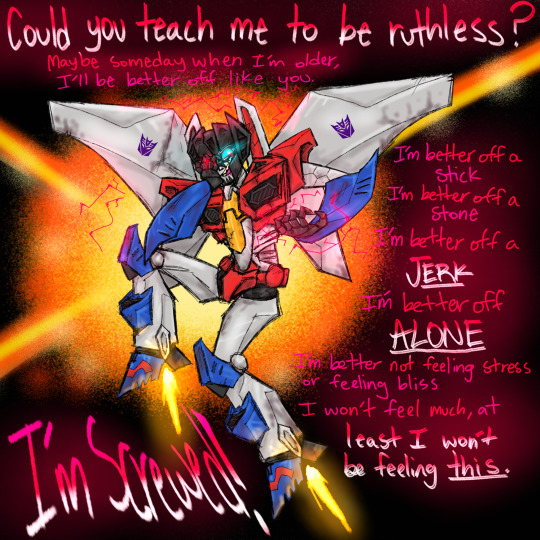
"But hey, what can you do? I'm a Touchy Feely Fool."
Some unhinged Starscream shit i was compelled to draw after listening to the thicc friggin playlist I made on loop, and this song by AJR has been a pretty constant mood
[forgot the "could I be unfeeling too" line lol oopsie]
#earthspark starscream#starscream#screamer lore in general really#i was staring at this shit for so long hopefully its not shit-#drawing bots is very interesting#lil bit of a feral lad#this would definitely be him @ megatron#who needs a null ray when that shit dont work on the buckethead and you have sketchy ass chaos powers now#instead of knife hands its gun hands#or the dark side of the force hands#zap zap#I want him to be able to absolutely pop off on a rant about his salt
83 notes
·
View notes
Text
do you think there is any elitism regarding tattoo application in cyberpunk? cause we see v's tattoo being applied automatically by a ripperdoc but i have to assume that tattoo artist is still a job, if even a dying one that's slowly being replaced by machines. like even today we see artists fighting for their work and the integrity of art in general versus ai, and i know in the tattoo community there have been similar things happening re: robotics/automated application within the last few years (look up BlackDot tattoo) and i just want to know what that community is like in 2077. there must still be old school corner tattoo shops right??
#cyberpunk 2077#genuinely dont know if there is any lore about this anywhere#but i was thinking about dagger's tattoos last night and how i just don't see him sitting down and letting a machine#apply his ink lmao. he's got several stick n pokes and for certain his chin tattoo was done by hand#but hes just such an old school type of person with an aversion to technology i don't think he'd want it done by an automated machine#i also have a tattoo artist oc who works out of a shop by hand and i just like. how common is that?????#did machines successfully choke out the artistry????#and do all ripperdocs have tattoo application knowledge as a baseline now because it just merged into that instead?#or is that specifically just the case with that dude who does v's tattoo whose name i don't rmr now cassius or whatever#and this doesn't even begin to touch on tattoos that have some kind of ingrained tech feature too...light up/glow in the dark#what does that tyger claw tattoo thing do its been too long since i played through rip#why is THERE SO MUCH TO THINK ABOUT???? HELLO?????????
38 notes
·
View notes